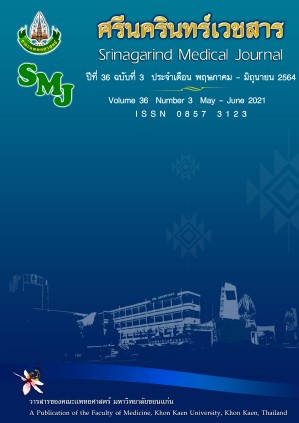ความต้องการและการได้รับการดูแลตามความต้องการของครอบครัวผู้ป่วยที่รับการรักษาในหอผู้ป่วยวิกฤต
Abstract
หลักการและวัตถุประสงค์ การที่มีบุคคลในครอบครัวเจ็บป่วยในภาวะวิกฤตทำให้สมาชิกในครอบครัว เกิดความเครียด กังวลใจ หากได้รับการดูแลอย่างเหมาะสมจะช่วยให้ครอบครัวจัดการกับภาวะเจ็บป่วยของผู้ป่วยได้ การศึกษานี้มีวัตถุประสงค์เพื่อศึกษาความต้องการ และการได้รับการดูแลตามความต้องการของครอบครัวผู้ป่วยที่รับการรักษาในหอผู้ป่วยวิกฤต
วิธีการศึกษา : เป็นการวิจัยเชิงพรรณนาใช้กรอบแนวคิดความต้องการของสมาชิกครอบครัวผู้ป่วยวิกฤตของกาลิโอเน่
กลุ่มตัวอย่างเป็นสมาชิกครอบครัวของผู้ป่วยที่รับการรักษาในหอผู้ป่วยวิกฤต โรงพยาบาลอุดรธานีจำนวน 132 คน คัดเลือกแบบเจาะจง เครื่องมือที่ใช้ในการวิจัยเป็นแบบสอบถาม ความต้องการและการได้รับการดูแลตามความต้องการของครอบครัวผู้ป่วย วิเคราะห์ข้อมูลด้วยสถิติพรรณนา และหาความสัมพันธ์โดยใช้สถิติสัมประสิทธิ์สหสัมพันธ์ ของเพียร์สัน
ผลการศึกษา : 1.ความต้องการของครอบครัวผู้ป่วยที่รับการรักษาในหอผู้ป่วยวิกฤต โดยรวมอยู่ระดับมากที่สุด 2.การได้รับการดูแลตามความต้องการของครอบครัวผู้ป่วยที่รับการรักษาในหอผู้ป่วยวิกฤต โดยรวมอยู่ในระดับมาก 3. ความสัมพันธ์ระหว่าง
ความต้องการและการได้รับการดูแลตามความต้องการของครอบครัวผู้ป่วยที่รับการรักษาในหอผู้ป่วยวิกฤตมีความสัมพันธ์ค่อนข้างต่ำ (r = 0.219, p ≤ 0.05)
สรุป: ผลการศึกษาเป็นแนวทาง ในการพัฒนาคุณภาพการดูแลให้สอดคล้องกับ ความต้องการของครอบครัวผู้ป่วยที่รับการรักษาในหอผู้ป่วยวิกฤต
คำสำคัญ: ความต้องการ; การได้รับการดูแล; ผู้ป่วยวิฤต; ครอบครัว
Background and objective: Having a family member getting sick in a crisis could stress and worry in other family members. If the patients receive a proper care, it will help them coping with the illness of the patients. This study aimed to assess needs and need responses of the family members of patients treated in the intensive care unit.
Materials and methods: This descriptive research was based on the family members’ need concept of Gaglione. The participants were 132 family members of the patients who were treated in the intensive care unit of Udonthani hospital using purposive sampling. The research instrument were needs and need-responses questionnaire. The data were analyzed by descriptive statistics and Pearson's correlation coefficient statistics.
Results: 1. The overall need score of family members of the patients treated in the intensive care unit was at the highest level. 2. The overall need-response score of family members was at the high level. 3. The Correlation coefficient of family members’ needs and need responses was significantly low. (r = 0.219, p ≤ 0.05)
Conclusion: The findings can be used to improve quality of care for family members of critically ill patients treated in the intensive care unit.
Keywords: Need; Need responses; Critically ill patients; Family members


